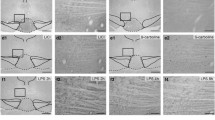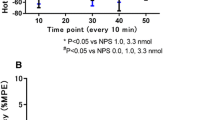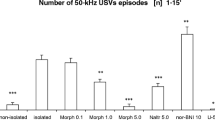Abstract
Rationale
Ultrasound vocalizations (USVs) at approximately 22 kHz are usual components of the defensive response of rats. However, depending on the neural substrate that is activated, such as the dorsal periaqueductal gray (dPAG), USV emissions may be reduced. Activation of neurokinin-1 (NK-1)-mediated mechanisms of the dPAG causes analgesia, reduced 22 kHz USVs, and anxiogenic-like effects in rats exposed to the elevated plus maze (EPM). Involvement of other types of neurokinin receptors in this activation has not yet been evaluated.
Objectives
The present study examined whether local injections of the selective NK-3 agonist senktide (1-100 pmol/0.2 μL) into the dPAG can (1) cause anxiogenic effects in the EPM, (2) influence novelty-induced 22 kHz USVs, or (3) change nociceptive reactivity in the tail-flick test.
Results
Senktide elicited a significant increase in exploratory behavior, an effect accompanied by hyperalgesia and an increase in the number of 22 kHz USVs. The nociceptive effects, increased locomotor activity, and USV emissions elicited by local injections of senktide (50 pmol/0.2 μL) were reduced by prior injections of the selective NK-3 receptor antagonist SB222200 (50 pmol/0.2 μL) into the dPAG.
Conclusions
These findings show that NK-3 receptors in the dPAG mediate nociceptive responses in this area, contrasting with the known fear-related processes mediated by NK-1 receptors in the dPAG. Both hyperalgesia and fear-related processes are accompanied by emissions of 22 kHz USVs.





Similar content being viewed by others
References
Adams DB (1979) Brain mechanisms for offense, defense, and submission. Behav Brain Sci 2:200–241
Adriani W, Laviola G (2004) Windows of vulnerability to psychopathology and therapeutic strategy in the adolescent rodent model. Behav Pharmacol 15:341–52
Aguiar MS, Brandão ML (1994) Conditioned place aversion produced by microinjections of substance P into the periaqueductal gray of rats. Behav Pharmacol 5:369–373
Aguiar MS, Brandão ML (1996) Effects of microinjections of the neuropeptide substance P in the dorsal periaqueductal gray on the behaviour of rats in the plus-maze test. Physiol Behav 60:1183–1186
Anseloni VZ, Brandão ML (1997) Ethopharmacological analysis of behaviour of rats using variations of the elevated plus-maze. Behav Pharmacol 8:533–540
Ardid D, Jourdan D, Eschalier A, Arabia C, Le Bars D (1993) Vocalization elicited by activation of A delta- and C-fibres in the rat. NeuroReport 5:105–108
Bandler R, Depaulis A (1988) Elicitation of intraspecific defence reactions in the rat from midbrain periaqueductal grey by microinjection of kainic acid, without neurotoxic effects. Neurosci Lett 88:291–296
Bannon MJ, Deutch AY, Tam SY, Zamir N, Eskay RL, Lee JM, Maggio JE, Roth RH (1986) Mild footshock stress dissociates substance P from substance K and dynorphin from Met- and Leu-enkephalin. Brain Res 381:393–396
Barbaresi P (1998) Immunocytochemical localization of substance P receptor in rat periaqueductal gray matter: a light and electron microscopic study. J Comp Neurol 398:473–490
Bassi GS, Nobre MJ, Carvalho MC, Brandão ML (2007a) Substance P injected into the dorsal periaqueductal gray causes anxiogenic effects similar to the long-term isolation as assessed by ultrasound vocalizations measurements. Behav Brain Res 182:301–307
Bassi GS, Nobre MJ, de Araújo JE, Brandão ML (2007b) Anxiogenic effects of activation of NK-1 receptors of the dorsal periaqueductal gray as assessed by the elevated plus-maze, ultrasound vocalizations and tail-flick tests. Neuropeptides 41:365–374
Bergström L, Torrens Y, Saffroy M, Beaujouan JC, Lavielle S, Chassaing G, Morgat JL, Glowinski J, Marquet A (1987) [3H]neurokinin B and 125I-Bolton Hunter eledoisin label identical tachykinin binding sites in the rat brain. J Neurochem 48:125–133
Blanchard RJ, Blanchard DC, Agullana R, Weiss SM (1991) Twenty-two kHz alarm cries to presentation of a predator, by laboratory rats living in visible burrow systems. Physiol Behav 50:967–972
Brandão ML, Coimbra NC, Borges PC (1990) Effects of morphine and midazolam on reactivity to peripheral noxious and central aversive stimuli. Neurosci Biobehav Rev 14:495–499
Brandão ML, Borelli KG, Nobre MJ, Santos JM, Albrechet-Souza L, Oliveira AR, Martinez RC (2005) Gabaergic regulation of the neural organization of fear in the midbrain tectum. Neurosci Biobehav Rev 29:1299–1311
Brodin E, Rosen A, Schott E, Brodin K (1994) Effects of sequential removal of rats from a group cage, and of individual housing of rats, on substance P, cholecystokinin and somatostatin levels in the periaqueductal grey and limbic regions. Neuropeptides 26:253–260
Brudzynski SM, Chiu EM (1995) Behavioural responses of laboratory rats to playback of 22 kHz ultrasonic calls. Physiol Behav 57:1039–1044
Brudzynski SM, Holland G (2005) Acoustic characteristics of air puff-induced 22-kHz alarm calls in direct recordings. Neurosci Biobehav Rev 29:1169–1180
Calvino B, Besson JM, Boehrer A, Depaulis A (1996) Ultrasonic vocalization (22–28 kHz) in a model of chronic pain, the arthritic rat: effects of analgesic drugs. NeuroReport 7:581–584
Castilho VM, Macedo CE, Brandão ML (2002) Role of benzodiazepine and serotonergic mechanisms in conditioned freezing and antinociception using electrical stimulation of the dorsal periaqueductal gray as unconditioned stimulus in rats. Psychopharmacology 165:77–85
Chahl LA (2006) Tachykinins and neuropsychiatric disorders. Curr Drug Targets 7:993–1003
Commissaris RL, Palmer A, Neophytou S, Graham M, Beckett S, Marsden CA (2000) Acoustically elicited behaviours in Lister hooded and Wistar rats. Physiol Behav 68:521–531
Commons KG, Valentino RJ (2002) Cellular basis for the effects of substance P in the periaqueductal gray and dorsal raphe nucleus. J Comp Neurol 447:82–97
Couture R, Boucher S, Picard P, Regoli D (1993) Receptor characterization of the spinal action of neurokinins on nociception: a three receptor hypothesis. Regul Pept 46:426–429
D’Amour FE, Smith DL (1941) A method for determining loss of pain sensation. J Pharmacol Exp Ther 72:9
Dableh LJ, Yashpal K, Rochford J, Henry JL (2005) Antidepressant-like effects of neurokinin receptor antagonists in the forced swim test in the rat. Eur J Pharmacol 507:99–105
De Araújo JE, Huston JP, Brandão ML (1998) Aversive effects of the C-fragment of substance P in the dorsal periaqueductal gray matter. Exp Brain Res 123:84–89
De Araújo JE, Silva RC, Huston JP, Brandão ML (1999) Anxiogenic effects of substance P and its 7-11 C-terminal, but not the 1-7 N-terminal, injected into the dorsal periaqueductal gray. Peptides 20:1437–1443
De Araújo JE, Huston JP, Brandão ML (2001a) Opposite effects of substance P fragments C (anxiogenic) and N (anxiolytic) injected into dorsal periaqueductal gray. Eur J Pharmacol 432:43–51
De Araújo JE, Huston JP, Brandão ML (2001b) Place aversion induced by microinjections of C-fragment of substance P into the dorsal periaqueductal gray of rats is mediated by tachykinin NK1 receptors. Peptides 22:1447–1452
De Luca-Vinhas MC, Macedo CE, Brandão ML (2006) Pharmacological assessment of the freezing, antinociception, and exploratory behavior organized in the ventrolateral periaqueductal gray. Pain 121:94–104
De Souza Silva MA, Mello EL Jr, Müller CP, Jocham G, Maior RS, Huston JP, Tomaz C, Barros M (2006) The tachykinin NK3 receptor antagonist SR142801 blocks the behavioral effects of cocaine in marmoset monkeys. Eur J Pharmacol 536:269–278
Dinh HK, Larkin A, Gatlin L, Piepmeier E Jr (1999) Rat ultrasound model for measuring pain resulting from intramuscularly injected antimicrobials. J Pharm Sci Technol 53:40–43
Drew GM, Mitchell VA, Vaughan CW (2005) Postsynaptic actions of substance P on rat periaqueductal grey neurons in vitro. Neuropharmacology 49:587–595
Duarte FS, Testolin R, De Lima TC (2004) Further evidence on the anxiogenic-like effect of substance P evaluated in the elevated plus-maze in rats. Behav Brain Res 154:501–510
Ebner K, Rupniak NM, Saria A, Singewald N (2004) Substance P in the medial amygdala: emotional stress-sensitive release and modulation of anxiety-related behavior in rats. Proc Natl Acad Sci U S A 101:4280–4285
Ebner K, Singewald N (2006) The role of substance P in stress and anxiety responses. Amino Acids 31:251–272
Fanselow MS, Helmstetter FJ (1988) Conditional analgesia, defensive freezing, and benzodiazepines. Behav Neurosci 102:233–243
Gaudreau GA, Plourde V (2003) Role of tachykinin NK1, NK2 and NK3 receptors in the modulation of visceral hypersensitivity in the rat. Neurosci Lett 351:59–62
Graeff FG (2004) Serotonin, the periaqueductal gray and panic. Neurosci Biobehav Rev 28:239–259
Graeff FG, Audi EA, Almeida SS, Graeff EO, Hunziker MH (1990) Behavioral effects of 5-HT receptor ligands in the aversive brain stimulation, elevated plus-maze and learned helplessness tests. Neurosci Biobehav Rev 14:501–506
Han JS, Bird GC, Li W, Jones J, Neugebauer V (2005) Computerized analysis of audible and ultrasonic vocalizations of rats as a astandardized measure of pain-related behavior. J Neurosci Methods 141:261–269
Hietal J, Nyman MJ, Eskola O, Laakso A, Gronroos T, Oikonen V, Bergman J, Haaparanta M, Forsback S, Marjamaki P, Lehikoinen P, Goldberg M, Burns D, Hamill T, Eng WS, Coimbra A, Hargreaves R, Solin O (2005) Visualization and quantification of neurokinin-1 (NK1) receptors in the human brain. Mol Imaging Biol 7:262–272
Hunsperger RW (1956) Affective reaction from electric stimulation of brain stem in cats. Helv Physiol Pharmacol Acta 14:70–92
Jelen P, Soltysik S, Zagrodzka J (2003) 22-kHz ultrasonic vocalization in rats as an index of anxiety but not fear: behavioral and pharmacological modulation of affective state. Behav Brain Res 141:63–72
Jenkinson KM, Mann PT, Southwell BR, Furness JB (2000) Independent endocytosis of the NK1 and NK3 tachykinin receptors in neurons of the rat myenteric plexus. Neuroscience 100:191–199
Jourdan D, Ardid D, Chapuy E, Eschalier A, Le Bars D (1995) Audible and ultrasonic vocalization elicited by single electrical nociceptive stimuli to the tail in the rat. Pain 63:237–249
Jourdan D, Ardid D, Chapuy E, Le Bars D, Eschalier A (1998) Effect of analgesics on audible and ultrasonic pain-induced vocalization in the rat. Life Sci 63:1761–1768
Jürgens U, Pratt R (1979) Role of the periaqueductal grey in vocal expression of emotion. Brain Res 167:367–378
Kramer MS, Cutler N, Feighner J, Shrivastava R, Carman J, Sramek JJ, Reines SA, Liu G, Snavely D, Wyatt-Knowles E, Hale JJ, Mills SG, MacCoss M, Swain CJ, Harrison T, Hill RG, Hefti F, Scolnick EM, Cascieri MA, Chicchi GG, Sadowski S, Williams AR, Hewson L, Smith D, Carlson EJ, Hargreaves RJ, Rupniak NM (1998) Distinct mechanism for antidepressant activity by blockade of central substance P receptors. Science 281:1640–1645
Laneuville O, Dorais J, Couture R (1988) Characterization of the effects produced by neurokinins and three agonists selective for neurokinin receptor subtypes in a spinal nociceptive reflex of the rat. Life Sci 42:1295–1305
Langlois X, Wintmolders C, te Riele P, Leysen JE, Jurzak M (2001) Detailed distribution of neurokinin 3 receptors in the rat, guinea pig and gerbil brain: a comparative autoradiographic study. Neuropharmacology 40:242–253
Li YQ, Jia HG, Rao ZR, Shi JW (1990) Serotonin-, substance P- or leucine-enkephalin-containing neurons in the midbrain periaqueductal gray and nucleus raphe dorsalis send projection fibers to the central amygdaloid nucleus in the rat. Neurosci Lett 120:124–127
Linden DR, Seybold VS (1999) Spinal neurokinin3 receptors mediate thermal but not mechanical hyperalgesia via nitric oxide. Pain 80:309–317
Linden DR, Jia YP, Seybold VS (1999) Spinal neurokin3 receptors facilitate the nociceptive flexor reflex via a pathway involving nitric oxide. Pain 80:301–308
Ljungdahl A, Hökfelt T, Nilsson G (1978) Distribution of substance P-like immunoreactivity in the central nervous system of the rat: I. Cell bodies and nerve terminals. Neuroscience 3:861–943
Maeno H, Kiyama H, Tohyama M (1993) Distribution of the substance P receptor (NK-1 receptor) in the central nervous system. Brain Res Mol Brain Res 18:43–58
Massi M, Panocka I, De Caro G (2000) The psychopharmacology of tachykin NK-3 receptors in laboratory animals. Peptides 21:1597–1609
Miczek KA, Thompson ML, Shuster L (1985) Naloxone injections into the periaqueductal grey area and arcuate nucleus block analgesia in defeated mice. Psychopharmacology 87:39–42
Mongeau R, De Oca BM, Fanselow MS, Marsden CA (1998) Differential effects of neurokinin-1 receptor activation in subregions of the periaqueductal gray matter on conditional and unconditional fear behaviors in rats. Behav Neurosci 112:1125–1135
Nagano M, Saitow F, Haneda E, Konishi S, Hayashi M, Suzuki H (2006) Distribution and pharmacological characterization of primate NK-1 and NK-3 tachykinin receptors in the central nervous system of the rhesus monkey. Br J Pharmacol 147:316–323
Nobre MJ, Brandão ML (2004) Analysis of freezing behavior and ultrasonic vocalization in response to foot-shocks, ultrasound signals and GABAergic inhibition in the inferior colliculus: effects of muscimol and midazolam. Eur Neuropsychopharmacol 14:45–52
Nobre MJ, Sandner G, Brandão ML (2003) Enhancement of acoustic evoked potentials and impairment of startle reflex induced by reduction of GABAergic control of the neural substrates of aversion in the inferior colliculus. Hear Res 84:82–90
Nunes Mamede Rosa ML, Nobre MJ, Ribeiro Oliveira A, Brandão ML (2005) Isolation-induced changes in ultrasonic vocalization, fear-potentiated startle and prepulse inhibition in rats. Neuropsychobiology 51:248–255
Papir-Kricheli D, Frey J, Laufer R, Gilon C, Chorev M, Selinger Z, Devor M (1987) Behavioural effects of receptor-specific substance P agonists. Pain 31:263–276
Paxinos G, Watson C (1997) The rat brain in stereotaxic coordinates. Academic, Sydney
Pellow S, Chopin P, File SE, Briley M (1985) Validation of open: closed arm entries in the elevated plus-maze as a measure of anxiety in the rat. J Neurosci Methods 14:149–167
Pennefather JN, Lecci A, Candenas ML, Patak E, Pinto FM, Maggi CA (2004) Tachykinins and tachykinin receptors: a growing family. Life Sci 74:1445–1463
Quartara L, Altamura M (2006) Tachykinin receptors antagonists: from research to clinic. Curr Drug Targets 7:975–992
Ranga K, Krishnan R (2002) Clinical experience with substance P receptor (NK1) antagonists in depression. J Clin Psychiatry 63(Suppl 11):25–29
Regoli D, Boudon A, Fauchere JL (1994) Receptors and antagonists for substance P and related peptides. Pharmacol Rev 46:551–599
Ribeiro SJ, Teixeira RM, Calixto JB, De Lima TC (1999) Tachykinin NK3 receptor involvement in anxiety. Neuropeptides 33:181–188
Rigby M, O'Donnell R, Rupniak NM (2005) Species differences in tachykinin receptor distribution: further evidence that the substance P (NK1) receptor predominates in human brain. J Comp Neurol 490:335–353
Rosen A, Brodin K, Eneroth P, Brodin E (1992) Short-term restraint stress and s.c. saline injection alter the tissue levels of substance P and cholecystokinin in the peri-aqueductal grey and limbic regions of rat brain. Acta Physiol Scand 146:341–348
Rosen A, Zhang YX, Lund I, Lundeberg T, Yu LC (2004) Substance P microinjected into the periaqueductal gray matter induces antinociception and is released following morphine administration. Brain Res 1001:87–94
Santarelli L, Gobbi G, Debs PC, Sibille ET, Blier P, Hen R, Heath MJ (2001) Genetic and pharmacological disruption of neurokinin 1 receptor function decreases anxiety-related behaviors and increases serotonergic function. Proc Natl Acad Sci U S A 98:1912–1917
Sarau HM, Griswold DE, Bush B, Potts W, Sandhu P, Lundberg D, Foley JJ, Schmidt DB, Webb EF, Martin LD, Legos JJ, Whitmore RG, Barone FC, Medhurst AD, Luttmann MA, Giardina GA, Hay DW (2000) Non peptide tachykinin receptor antagonists: II. Pharmacological and pharmacokinetic profile of SB-222200, a central nervous system penetrant, potent and selective NK-3 receptor antagonist. J Pharmacol Exp Ther 295:373–381
Sculptoreanu A, de Groat WC (2007) Neurokinins enhance excitability in capsaicin-responsive DRG neurons. Exp Neurol 205:92–100
Shaikh MB, Steinberg A, Siegel A (1993) Evidence that substance P is utilized in medial amygdaloid facilitation of defensive rage behavior in the cat. Brain Res 625:283–294
Shughrue PJ, Lane MV, Merchenthaler I (1996) In situ hybridization analysis of the distribution of neurokinin-3 mRNA in the rat central nervous system. J Comp Neurol 372:395–414
Siegel RA, Duker EM, Pahnke U, Wuttke W (1987) Stress-induced changes in cholecystokinin and substance P concentrations in discrete regions of the rat hypothalamus. Neuroendocrinology 46:75–81
Smith ME, Flynn FW (2000) Distribution of Fos-like immunoreactivity within the rat brain following intraventricular injection of the selective NK3 receptor agonist senktide. J Comp Neurol 426:413–428
Tomazini FM, Reimer A, Albrechet-Souza L, Brandão ML (2006) Opposite effects of short- and long-duration isolation on ultrasonic vocalization, startle and prepulse inhibition in rats. J Neurosci Methods 153:114–120
Varty GB, Cohen-Williams ME, Morgan CA, Pylak U, Duffy RA, Lachowicz JE, Carey GJ, Coffin VL (2002) The gerbil elevated plus-maze II: anxiolytic-like effects of selective neurokinin NK1 receptor antagonists. Neuropsychopharmacology 27:371–379
Vianna DM, Landeira-Fernandez J, Brandão ML (2001) Dorsolateral and ventral regions of the periaqueductal gray matter are involved in distinct types of fear. Neurosci Biobehav Rev 25:711–719
van der Poel AM, Noach EJ, Miczek KA (1989) Temporal patterning of ultrasonic distress calls in the adult rat: effects of morphine and benzodiazepines. Psychopharmacology 97:147–148
Vivian JA, Miczek KA (1998) Effects of μ and δ opioid agonists and antagonists on affective vocal and reflexive pain responses during social stress in rats. Psychopharmacology 139:364–375
Vivian JA, Farrell WJ, Sapperstein SB, Miczek KA (1994) Diazepam withdrawal: effects of diazepam and gepirone on acoustic startle-induced 22 kHz ultrasonic vocalizations. Psychopharmacology 114:101–108
Wohr M, Borta A, Schwarting RK (2005) Overt behavior and ultrasonic vocalization in a fear conditioning paradigm: a dose–response study in the rat. Neurobiol Learn Mem 84:228–240
Xin L, Geller EB, Liu-Chew LY, Chew C, Adler MW (1997) Substance P release in the rat periaqueductal gray and preoptic anterior hypothalamus after noxious cold stimulation: effect of selective mu and kappa opioid agonists. J Pharmacol Exp Ther 282:1055–1063
Yip J, Chahl LA (1999) Distribution of Fos-like immunoreactivity in guinea-pig brain following administration of the neurokinin-1 receptor agonist, [SAR9,MET(O2)11]substance P. Neuroscience 94:663–673
Yip J, Chahl LA (2001) Localization of NK1 and NK3 receptors in guinea-pig brain. Regul Pept 98:55–62
Acknowledgments
This work was supported by FAPESP (06/06354-5 and 06/03930-5) and CNPq (06/472030-0).
Author information
Authors and Affiliations
Corresponding author
Rights and permissions
About this article
Cite this article
Bassi, G.S., Broiz, A.C., Gomes, M.Z. et al. Evidence for mediation of nociception by injection of the NK-3 receptor agonist, senktide, into the dorsal periaqueductal gray of rats. Psychopharmacology 204, 13–24 (2009). https://doi.org/10.1007/s00213-008-1434-y
Received:
Accepted:
Published:
Issue Date:
DOI: https://doi.org/10.1007/s00213-008-1434-y




